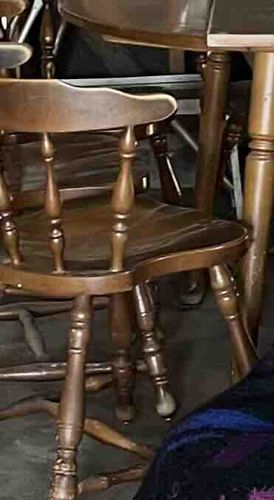
Vintage Wooden Dining Chair (Windsor-style)
This appears to be a vintage wooden kitchen or dining chair, likely from the mid-20th century, possibly in a colonial or farmhouse style. The chair is constructed from solid wood, displaying a warm, medium-brown finish, likely stained to enhance the wood grain. Its design features a curved, saddle-shaped seat, suggesting an ergonomic approach to comfort. The backrest is composed of multiple turned spindles, which rise to meet a curvilinear, flat top rail, characteristic of Windsor-style chairs or similar vernacular furniture. The legs are also turned and appear robust, with visible stretchers connecting them, adding to the structural integrity. One front leg exhibits a distinct turning pattern, possibly a baluster or reel turning. There are some visible signs of wear consistent with age and use, including scuffs, scratches, and potential fading of the finish, particularly on the edges and high-contact areas. The overall construction suggests solid craftsmanship, though no specific maker's marks are discernible from the provided image. The patina indicates a history of use, and while there are no obvious major damages like breaks or cracks, a thorough inspection would be needed to confirm structural soundness.
AI-Generated Appraisal Disclaimer
Estimated Value
$75-125
Basic Information
Category
Furniture
Appraised On
December 7, 2025
Estimated Value
$75-125
Item Description
This appears to be a vintage wooden kitchen or dining chair, likely from the mid-20th century, possibly in a colonial or farmhouse style. The chair is constructed from solid wood, displaying a warm, medium-brown finish, likely stained to enhance the wood grain. Its design features a curved, saddle-shaped seat, suggesting an ergonomic approach to comfort. The backrest is composed of multiple turned spindles, which rise to meet a curvilinear, flat top rail, characteristic of Windsor-style chairs or similar vernacular furniture. The legs are also turned and appear robust, with visible stretchers connecting them, adding to the structural integrity. One front leg exhibits a distinct turning pattern, possibly a baluster or reel turning. There are some visible signs of wear consistent with age and use, including scuffs, scratches, and potential fading of the finish, particularly on the edges and high-contact areas. The overall construction suggests solid craftsmanship, though no specific maker's marks are discernible from the provided image. The patina indicates a history of use, and while there are no obvious major damages like breaks or cracks, a thorough inspection would be needed to confirm structural soundness.
Related Tags
Get Your Items Appraised
Instant estimates of your treasures with AI-powered instant appraisals